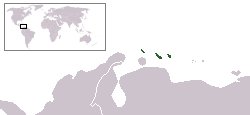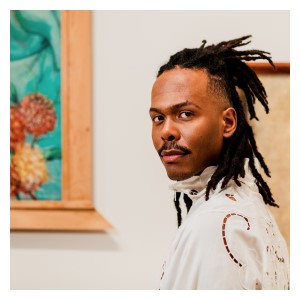
Suriname, officially the Republic of Suriname, is a country in northern South America, sometimes considered part of the Caribbean and the West Indies. Situated slightly north of the equator, over 90% of its territory is covered by rainforests, the highest proportion of forest cover in the world. Suriname is bordered by the Atlantic Ocean to the north, French Guiana to the east, Guyana to the west, and Brazil to the south. It is the smallest country in South America by both population and territory, with around 612,985 inhabitants in an area of approximately 163,820 square kilometers. The capital and largest city is Paramaribo, which is home to roughly half the population.

This is a demography of the population of Suriname, including population density, ethnicity, education level, health of the populace, economic status, religious affiliations, and other aspects of the population.
"God zij met ons Suriname", or "Opo kondreman", is the national anthem of Suriname. It has two verses: the first in Dutch and the second in Sranan Tongo.

Papiamento or Papiamentu is a Portuguese-based creole language spoken in the Dutch Caribbean. It is the most widely spoken language on the Caribbean ABC islands.

Carib or Kari'nja is a Cariban language spoken by the Kalina people (Caribs) of South America. It is spoken by around 7,400 mostly in Brazil, The Guianas, and Venezuela. The language is currently classified as highly endangered.
Saramaccan is a creole language spoken by about 58,000 people of West African descent near the Saramacca and the upper Suriname River, as well as in Paramaribo, capital of Suriname. The language also has 25,000 speakers in French Guiana and 8,000 in the Netherlands. It has three main dialects. The speakers are mostly descendants of fugitive slaves who were native to West and Central Africa; they form a group called Saamacca, also spelled Saramaka.
Nigerian Pidgin, also known as Naija or Naijá in scholarship, is an English-based creole language spoken as a lingua franca across Nigeria. The language is sometimes referred to as Pijin, Brokun 'Ullu' or "Vernacular". It can be spoken as a pidgin, a creole, dialect or a decreolised acrolect by different speakers, who may switch between these forms depending on the social setting. In the 2010s, a common orthography was developed for Pidgin which has been gaining significant popularity in giving the language a harmonized writing system.

Ndyuka, also called Aukan, Okanisi, Ndyuka tongo, Aukaans, Businenge Tongo, Eastern Maroon Creole, or Nenge is a creole language of Suriname and French Guiana, spoken by the Ndyuka people. The speakers are one of six Maroon peoples in the Republic of Suriname and one of the Maroon peoples in French Guiana. Most of the 25 to 30 thousand speakers live in the interior of the country, which is a part of the country covered with tropical rainforests. Ethnologue lists two related languages under the name Ndyuka, the other being a dialect of Lutos.

Surinamese Dutch also known as Surinaams is the form of Dutch spoken in Suriname and is the official language in Suriname, a former Dutch colony. Dutch is spoken as a native language by about 80% of the population, most of them being bilingual with Sranan Tongo, Hindustani, Javanese, and other languages. Nevertheless, Dutch is the sole official language of the country. Surinamese Dutch is easily intelligible with other forms of Dutch. Furthermore, as opposed to other languages that have different forms in the Americas the regulation and thus standardised spelling of the Dutch language is done through a joint Dutch–Belgian–Surinamese organization, the Dutch Language Union, and thus has no regional differences regarding spelling. Suriname has been an associate member of this Nederlandse Taalunie since 2004. Therefore, many typical Surinamese words were added to the official Wordlist of Standard Dutch, known as "the Green Booklet".

Surinamese people are people who identify with the country of Suriname. This connection may be residential, legal, historical or cultural. For most Surinamese, several of these connections exist and are collectively the source of their being Surinamese.
Kwinti is an English-based creole of Suriname closely related to Ndyuka. The language has less than 300 speakers, and split from Plantation Creole which is nowadays known as Sranan Tongo in the middle 18th century. Code-switching with Sranan Tongo and Dutch was common among the younger generation in 1973, and about 70% of the tribe have moved to the urban areas. UNESCO considers the language endangered.
NAKS is a social and cultural organization which promotes Afro-Surinamese culture and expression in Suriname and worldwide. The organisation was founded in 1948 with Eugène Drenthe as its first president, when it emerged as the successor of association football club T.O.P. which was founded a year prior.

The Matawai are a tribe of Surinamese Maroons. The Matawai were originally part of the Saramaka, and signed a peace agreement with the Dutch colonists in 1762. The tribe split from the Saramaka, and in 1769, they were recognized as a separate tribe.

Eduard Johan "Eddy" Bruma was a Surinamese politician, lawyer and writer.

Julius Gustaaf Arnout Koenders was a Surinamese teacher and fervent activist for Sranan Tongo. As a teacher, he was forced to use the Dutch language thus denying the children their own language. He was an early advocate of Sranan and Creole culture.
Sranan Tongo, or for short Sranan, an English-based creole language spoken by many people in Suriname, is not an officially recognized language. Until the middle of the 20th century, most written texts in Sranan, seen at the time as a low-prestige language, used a spelling that was not standardized but based on Dutch orthography, recording an approximation of how Sranan words sound to Dutch ears. In view of the considerable differences between the phonologies of Sranan and Dutch, this was not a satisfactory situation.

"Birth of a New Age" is a song by Surinamese singer-songwriter Jeangu Macrooy. The song represented the Netherlands in the Eurovision Song Contest 2021 in Rotterdam, the Netherlands. The music video was recorded in the Rijksmuseum. In the song, Macrooy calls for resilience and authenticity. The song is mostly written in English and partly in Sranan Tongo, a lingua franca in Suriname.

Johannes Helstone, born Nicodemus Johannes Helstone, was a Surinamese composer, pianist and writer. He is best known for his 1906 opera Het Pand der Goden.

The statue of Kwakoe in the Surinames capital Paramaribo is a monument commemorating the abolition of slavery. It was made by the sculptor Jozef Klas.

Christiaan Hendrik "Hein" Eersel was a Surinamese linguist and cultural researcher.













